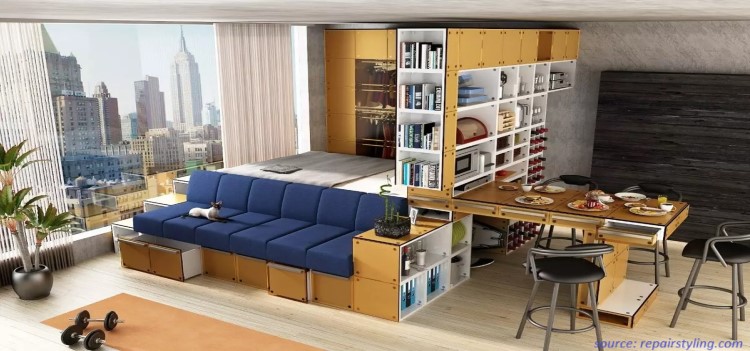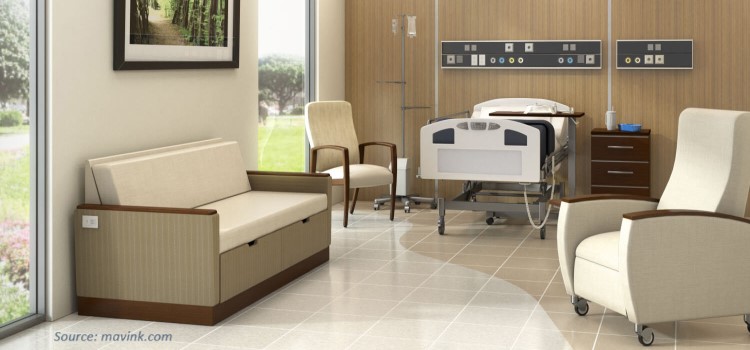Revolutionizing Living Spaces through Cutting-Edge Innovations in the Furniture Industry
17-Sep-2024

Introduction
In the dynamic realm of interior design, the furniture industry stands at the forefront of innovation. The industry is consistently evolving in the way people perceive and experience their living spaces. The integration of cutting-edge technologies and groundbreaking design concepts has ushered in a new era, revolutionizing the very essence of furniture. This article delves into the transformative journey of the furniture industry and explores the latest innovations that are redefining the boundaries of comfort, aesthetics, and functionality.
1. Multifunctional Furniture Design
As property prices surge and cities grow more crowded than before, the need to maximize living spaces with durable furniture becomes increasingly crucial. Multifunctional furniture designs integrate advanced technology to create space-saving and visually appealing furniture. Up-and-coming startups craft furniture with modular designs and advanced folding mechanisms to ensure optimal storage.
For instance, multifunctional desks can transform into wall-mounted shelves or fold into compact units when not in use. Materials such as aluminum, steel, wood, and even cardboard are employed in creating such furniture. Furthermore, startups and scaleups are utilizing natural resources to produce sustainable furniture that is foldable, stackable, and transformable.
Hoek Home, a U.S.-based startup specializing in modular furniture design, produces modular furniture with patented snap-lock and flat-pack systems. The snap-lock system facilitates easy assembly and disassembly of furniture without the need for tools or extensive instructions. Additionally, the flat-pack system ensures each furniture component packs into an easily transportable item. The startup’s quick-assembly furniture serves multiple purposes, such as a desk, table, bookshelf, and others.
Moreover, Flowfactory, an Austrian startup, has ingeniously designed a window seat that hangs within a workspace and serves as a multifunctional table or shelf. When folded, it converts the window recess into a mini-balcony alternative, offering comfortable and secure seating by the window.
The startup sells multifunctional furniture to optimize living space, providing employees with additional space to relax and concentrate. These startups exemplify the fusion of functionality, sustainability, and design excellence. Such initiatives give a promise to the future where living spaces are optimized without compromising aesthetics or environmental responsibility.
2. Smart Furniture
In today's ever-changing world, furniture makers are adapting to customers' evolving preferences. A game-changer in this field is the Internet of Things (IoT). This technology is revolutionizing how furniture is made. Companies now craft smart furniture with sensor technology to track real-time user data. This seamless fusion of technology and furniture not only improves functionality but also enhances the overall design.
Smart furniture has various features, including wireless charging, built-in speakers, health monitoring systems, and others. These pieces can also be voice-enabled, and connect with Wi-Fi, Bluetooth, and other home IoT devices. For example, smart beds that use biometric sensors to monitor breathing rate, heart rate, and restfulness. By integrating IoT, furniture makers can prolong the lifespan of their products by identifying potential issues and maintenance needs.
In the U.S., NextErgo is making waves with its AI-powered smart desk designed for ergonomic comfort. Equipped with posture correction and built-in presence detection sensors, this desk uses thermal imaging and hand-level detection to help users maintain a healthy standing posture. The desk also features voice control through Google Assistant and a touchscreen for user interaction.
This allows users to set reminders for breaks, hydration, snacks, and even prompts for moving different body parts through on-screen and vocal notifications. As a result, it enhances user posture while boosting energy levels and overall productivity.
Also, Invisible Tech, a Hong Kong-based startup, has taken the smart furniture technology further by creating furniture with embedded audio for top-notch sound quality. The audio system ensures seamless wireless listening and enhances the user experience.
The startup upcycles waste wood materials, making its smart audio system environmentally sustainable. Invisible Tech customizes its products to cater to individual preferences, addressing the rising demand for improved smart living experiences. In the realm of furniture, these innovations represent a significant leap forward, offering not just functional enhancements but also a touch of sophistication for the modern lifestyle.
3. Additive Manufacturing
The adoption of additive manufacturing, also known as 3D printing technology, is transforming traditional production approaches. This innovation enhances the flexibility of designs, reduces costs, and allows for customized furniture. 3D printing simplifies furniture production by addressing challenges related to shapes, materials, functions, and complex structures. It is particularly useful in creating molds for furniture, making intricate shapes quickly, and reducing the expenses associated with molding.
Common 3D printing technologies in furniture production include photocuring molding and selective laser sintering (SLS). This approach tackles slow product updates, long research & development, and production cycles. The integration of 3D printing in furniture enables manufacturers to create more detailed and innovative designs at lower costs and in lesser time than before.
C3D Printing, a startup in the UAE, specializes in producing large-format 3D-printed furniture using plastic granules. Its large printers allow for faster creation of bigger, more complex, and more detailed furniture pieces than before. It uses fused deposition modeling for strong and durable furniture components and a stereolithography technique with liquid resin for high-resolution prints. This approach helps manufacturers create intricate, customized, and high-quality large furniture while reducing costs and environmental impact.
Another player in this field is Labec Design, an Italian startup advancing furniture 3D printing. It utilizes techniques such as fused deposition modeling (FDM) and selective laser sintering (SLS). Labec Design's high-performance 3D printers ensure a smooth transition from digital design to a physical product using surface tessellation language files. These printers can process various materials, including polylactic acid (PLA), thermoplastic polyurethane (TPU), and acrylonitrile butadiene styrene (ABS). The startup’s solutions enable furniture manufacturers to prototype furniture using sustainable materials.
4. Immersive Technologies
The integration of immersive technologies stands as a pivotal innovation within the furniture industry. This strategic adoption empowers furniture companies to present their products in a photorealistic manner, leveraging immersive technologies, such as augmented reality, virtual reality, and extended reality (XR). By offering customers realistic simulations of furniture, companies enable virtual trials before purchase, elevating the overall buying experience.
The lifelike renderings and accurate product representations give customers a thorough understanding of the product, allowing them to view it from all angles. Buyers can also check whether the furniture dimensions fit their available space and if the colors complement their surroundings. Embracing immersive technologies not only enhances the overall shopping experience for customers but also helps furniture companies bridge the gap between physical stores and online retail.
For example, Ruupi is a Lithuanian startup that utilizes virtual reality for product demonstrations and immersive shopping experiences. This approach enhances the online buying experience by allowing customers to visualize furniture items in a catalog before making a purchase.
Similarly, NXT Interactive, a Singaporean startup, developed a web-AR furniture app that showcases real-time 3D models of furniture. Using augmented reality, this app enables customers to visualize how furniture will look in their personal spaces, aiding in purchasing decisions. These interactive experiences empower customers to make informed decisions about their furniture choices without physically visiting a store, ultimately improving the overall shopping experience.
5. Sustainable Furniture
Furniture production contributes significantly to the global carbon footprint. Recognizing the growing demand for environmentally friendly practices, there is a notable shift in the furniture industry toward using eco-friendly materials.
Additionally, furniture companies face challenges with shortages of raw materials. To address this, recycling and upcycling processes are implemented to make the most of resources and extend their lifespan. Bio-based materials, for instance, are emerging as a promising alternative to plastic in making furniture and its components.
Startups also make strides by producing furniture from recycled materials and renewable resources such as old wood fibers, PET bottles, bamboo, cotton, and algae. Manufacturers create furniture fittings, glides, wheels, and castors entirely from renewable materials using injection molding. This approach helps furniture companies meet sustainability goals by responsibly sourcing materials without resorting to toxic chemicals.
Another notable startup, Gravity Wave from Spain, manufactures recycled furniture to preserve the environment and combat ocean pollution. By transforming ocean plastic waste into sustainable furniture such as recycled tables, benches, and pots, it showcases the versatility of these materials in adapting to various shapes and spaces for interior design and architectural decorations. Its circular furniture manufacturing process promotes sustainability in the industry, contributing to environmental preservation.
Another prime example is Calico Sol, a U.S.-based startup specializing in sustainable home furnishings. They focus on reducing the overall carbon footprint and promoting reuse & recycling concepts. Calico Sol offers custom furniture made from stain-resistant and durable textiles, which are cost-effective, easy to dispose of, and environmentally sustainable. All of its furnishings are crafted entirely from natural, less resource-intensive, and non-toxic materials. Its circular design further aids furniture manufacturers in minimizing waste and keeping materials in use.
Conclusion
The furniture industry is undergoing a remarkable transformation, driven by a confluence of technological advancements, sustainable practices, and a redefined approach to design. The revolution of living spaces through cutting-edge innovations signifies a dedication to improving the quality of life for consumers, while embracing a more sustainable and interconnected future. As people continue to witness the evolution of the furniture industry, one thing remains certain – the journey to redefine living spaces is an ongoing and inspiring adventure.
About the Author
 Sunanda Ghosh is a researcher with more than 3 years of experience. She has a passion for understanding consumer behavior and market trends, and uses her skills in innovative ways to gather and analyze data. Throughout her career, she has worked with a diverse range of global clients across various industries including technology, semiconductor, and energy. She is dedicated to providing valuable insights that can help shape a company's direction and drive success. The author can be reached at info@nextmsc.com
Sunanda Ghosh is a researcher with more than 3 years of experience. She has a passion for understanding consumer behavior and market trends, and uses her skills in innovative ways to gather and analyze data. Throughout her career, she has worked with a diverse range of global clients across various industries including technology, semiconductor, and energy. She is dedicated to providing valuable insights that can help shape a company's direction and drive success. The author can be reached at info@nextmsc.com








